
Cannabis Grow Lights: LED Vs HPS
HPS grow lights have long been the standard among indoor cannabis growers. LEDs, on the other hand, are the new kid on the block, generating a lot of hype, and not always in a good way. In this article, we'll teach you all there is to know about LED vs HPS lighting for growing cannabis.
Your grow lights are easily the most important piece of equipment in your grow room or tent. And in today’s market, cannabis growers typically choose between two types of lighting systems; high-pressure sodium (HPS) or light-emitting diode (LED).
In this article, we’ll weigh up the pros and cons of both LED and HPS lights to help you make an informed decision about the right lighting system for your next grow.
Why light matters for cannabis cultivation
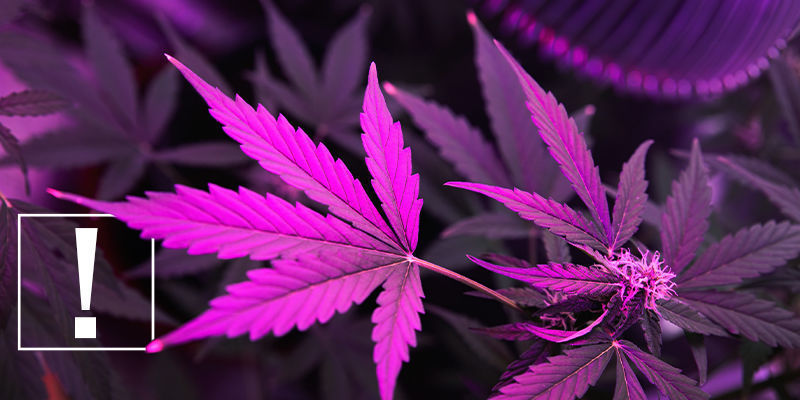
Cannabis plants naturally grow best in sunny spots outdoors. When we cultivate indoors, we need to do our best to mimic the sun and give our cannabis plants plenty of strong, direct light to promote a healthy vegetative and flowering stage.
When it comes to indoor lighting for cannabis plants, HPS and LED setups are by far the most popular for achieving high-quality harvests. Both have very clear advantages and drawbacks, which we’ll explore in more depth throughout this article.
What are LED grow lights?
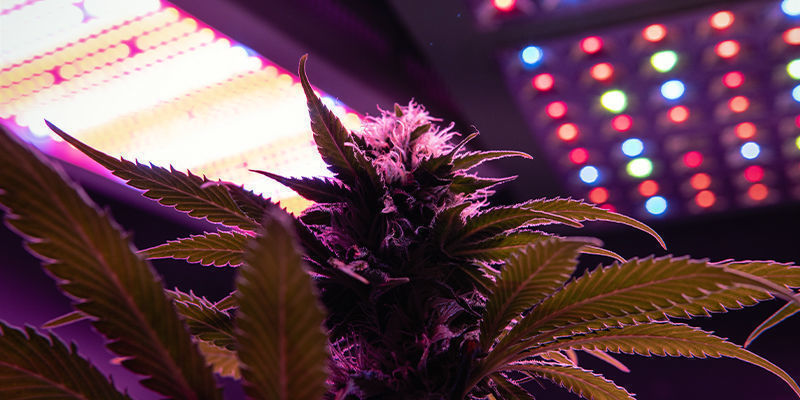
While LEDs have become increasingly popular in regular lighting fixtures, LED technology is relatively new to the cannabis space. And it didn’t exactly get off to a great start among growers.
LED grow lights hit the market hard with promises of delivering better growth, bigger yields, and increased potency, all while reducing running costs. For many growers, however, early LEDs failed to deliver. Cheap LED grow lights, in particular, quickly became infamous among growers for delivering subpar results.
However, new LEDs have come a long way and are more than capable of holding their own compared to HPS lighting, which has long been a favourite among weed growers. Quality LEDs can produce great grows with impressive yields (both in weight and potency).
The only real problem left with LED grow lights is that they aren’t standardised like HPS lights. Hence, quality can vary quite dramatically from one brand to another, meaning growers have to do their research prior to making a purchase. In our experience, we recommend sticking to tried and tested brands and staying away from LEDs that are cheap and promise the world.
What are HPS grow lights?
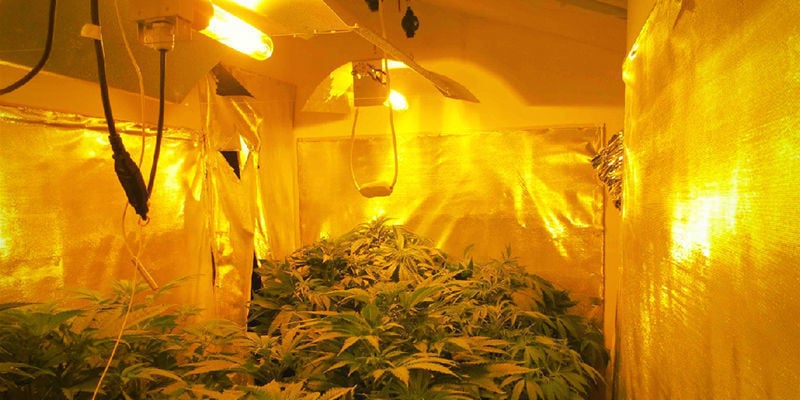
High-pressure sodium lights have long dominated indoor cannabis growing, becoming renowned for producing reliable results harvest after harvest. These lights can vary greatly in wattage (from 75–4,000 watts), produce plenty of lumens (light energy), and have the ideal CCT (correlated colour temperature) for growing cannabis.
HPS lights are a type of high-intensity discharge (HID) lighting system alongside the likes of metal halide (MH) grow lights. They come in all shapes and sizes, and are typically cheaper to buy outright than LEDs, making them very versatile and accessible to growers with all kinds of budgets.
It’s worth noting that, typically, metal halide lights are intended for vegging, whereas HPS are used to support the flowering stage. This is because the light spectrum of HPS bulbs is more supportive of flowering than growth. That doesn’t mean you still can’t achieve great results growing exclusively with HPS, but it’s something to consider.
LED grow lights vs HPS grow lights
Now that you’ve been introduced to both lighting systems, let's dive a little deeper into the differences and pros and cons of each. The truth is that both HPS and LED grow lights can produce great results; choosing one over the other will largely depend on your preferences and objectives as a grower, your budget, and the size of your grow room or tent.
Below, we’ll compare HPS vs LED in terms of cost, energy consumption, ease of use, yield, and safety.
Cost and energy consumption
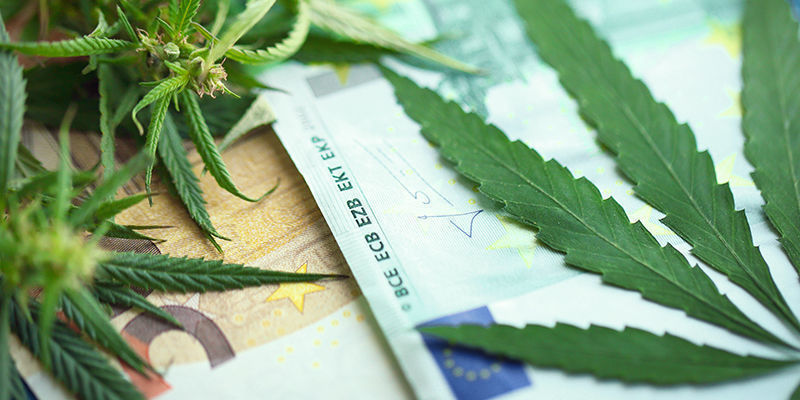
Operating an indoor cannabis garden obviously comes at a cost. Grow lights, fans, extractors, timers, ballasts, and automated watering systems all run on electricity, and the costs of keeping this equipment running for a typical 12–16-week grow cycle can quickly add up. Grow lights are typically the biggest energy consumers in an indoor garden, and thus your choice of lighting system will have a big impact on the running costs of your entire operation.
LEDs outperform HPS grow lights in terms of running costs and energy use on many levels; not only do they require less electricity to produce the same amount of illumination, but LEDs also run much cooler than HPS, meaning you can save on ventilation. Moreover, LED grow lights have very long lifespans and, unlike HPS lights, maintain a constant level of luminosity as long as they remain functional.
While quality LEDs come at a higher upfront cost, the energy savings they promote will pay off over time, and have made them increasingly popular among weed growers.
| LED |
HPS |
| Pros | |
| ✔️ High-quality LEDs use about 70% less electricity to produce the same amount of illumination as HPS lights. | ✔️ Much cheaper than LEDs. |
| ✔️ LED lights have long lifespans of up to 100,000 hours. | ✔️ HPS grow light replacements and parts are also cheaper and easier to find than LED parts. |
| ✔️ Produce minimal heat, meaning you often don’t have to account for them when setting up your ventilation/extractors. | ✔️ HPS lights are standardised, with less variation in quality between brands. |
| Cons | |
| ❌ More expensive outright than HPS lights. | ❌ Far less efficient than LEDs. |
| ❌ LEDs aren’t standardised like HPS, meaning quality can vary considerably from one brand to another. | ❌ HPS lights run at extremely high temperatures (up to 3000°C). Most of that heat gets turned into infrared radiation, which needs to be compensated for with proper ventilation to avoid damaging your plants. |
| ❌ Cheap LED grow lights are typically very low in quality and produce poor yields that don’t justify the cheaper running costs. | |
| ❌ The fact that LEDs produce almost no heat may pose problems for indoor growers living in cold areas of the globe or growing throughout winter. | |
Ease of use
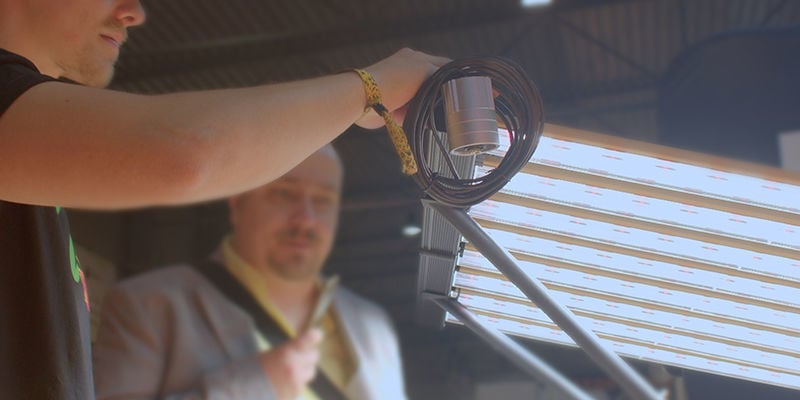
Both HPS and LED grow lights are fairly easy to use. Many high-quality modern LEDs are full spectrum, meaning they closely mimic the sun and provide the necessary wavebands to support both the vegetative and flowering stage. Other LED fixtures come with veg and bloom switches to simplify the transition in colour temperature, especially for beginner growers. Setting up LEDs is also pretty straightforward since they typically don’t need to be connected to a ballast and don’t necessarily require much ventilation.
HPS lights, while not exactly difficult to use, may be a little trickier to set up than LEDs, since they need to be connected to a ballast (to ensure the bulbs receive the right amount of current) as well as timers to automate the light cycle in your tent/room. While setting this all up is far from rocket science, it may seem a little more daunting to rookie growers. The fact that HPS lights need to be accompanied by good ventilation to mitigate the heat adds an extra layer of complexity to their setup.
Finally, while calculating the right size of grow light for your grow room can pose a problem for some, there are plenty of online tools and resources out there to help simplify this process. Keep in mind that, due to the heat they produce, HPS lights typically aren’t well-suited to small grow tents or rooms as they may damage or burn your plants if hung too close to the canopy. On the other hand, HPS can be easier to space because they have a broader footprint than LEDs, which have beam angles that vary greatly.
| LED |
HPS |
| Pros | |
| ✔️ Do not need to be connected to a ballast. | ✔️ Less expensive. |
| ✔️ Often deliver a full spectrum of light, or come with switches to easily transition colour temperature from the vegetative stage to the flowering stage. | ✔️ Easier to replace/repair if parts break. |
| ✔️ Don’t necessarily need to be accompanied by an extractor fan to keep your grow tent/room cool. | ✔️ Easier to space in larger grow rooms thanks to their broad beam angles. |
| Cons | |
| ❌ More expensive. | ❌ Require ballasts, timers, and exhaust fans to run properly. Investing and setting up this extra equipment may be daunting for rookie growers. |
| ❌ Growers operating large tents or rooms that require multiple grow lights may not be able to afford/justify investing in LED setups. | ❌ May not be suitable for small grows due to the heat they produce. |
Yields
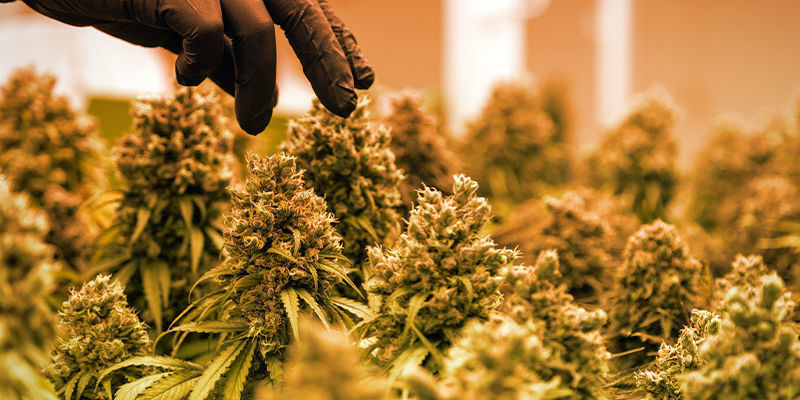
This is arguably the hottest topic in the HPS vs LED debate, and also the one riddled with the most misinformation.
When LEDs first hit the market, they received heavy criticism for producing subpar yields; that is, buds that not only lacked potency, aroma, and flavour, but also weighed less than their HPS-grown counterparts. As mentioned, LEDs have come a long way since they first hit the market, but, unfortunately, the bad reputation they received early on still precedes them.
Today, a high-quality LED grow light should be able to produce the same (if not better) yield quality as a HPS fixture. In terms of weight, a long-considered standard for HPS has been 0.5 grams per lamp wattage (meaning a 1000W HPS light should produce up to 500g of bud).
LEDs, on the other hand, have been shown to yield up to 1.16g per watt. Other research claims that LED lights promote the development of more nodes (meaning more bud sites) and higher concentrations of cannabinoids and terpenes.[2]
Keep in mind that, of course, these results aren’t guaranteed. The truth is that the quality of bud you harvest comes down largely to your skill and resources as a grower, not just the type of lighting fixture you choose to use. Nonetheless, keep the research mentioned above in mind, especially when a grower tries to convince you that LEDs aren’t worth their weight.
| LED |
HPS |
| Pros | |
| ✔️ Capable of producing over 1g of bud per watt. | ✔️ Have a cheaper outright cost. |
| ✔️ Studies suggest LED lights encourage the production of more nodes and higher terpene and cannabinoid concentrations. | ✔️ Long considered “the standard” among cannabis growers. |
| ✔️ Produce up to 0.5g per watt. | |
| Cons | |
| ❌ Cheap models sacrifice quality and will likely produce poor yields. | ❌ Potentially lower production of cannabinoids, terpenes, and nodes. |
| ❌ Quality LEDs come at a higher upfront cost. | ❌ Potentially lower yields per watt. |
Safety

Safety is a major concern for any serious marijuana grower. While growing cannabis isn’t exactly dangerous, it’s always important to enforce certain safety measures when operating high-wattage electrical equipment for multiple hours per day over extended periods of time (which is the case when operating a grow room).
The main safety concern with HPS lights, again, has to do with the amount of heat they produce. Growers often jokingly compare their HPS lights to electric heaters, and the comparison really isn’t far off.
Due to their heat production, growers using HPS need to take measures to keep the temperatures in their grow rooms/tents stable, not only to protect their plants from heat damage, but also to prevent fires. Ballasts are also a necessary safety measure in any HPS grow room to ensure lights aren’t overfed and explode. The fact that HPS lights are more complicated to set up (as mentioned under “ease of use”) also leaves more room for human error, which could pose safety issues.
LEDs aren’t without their safety concerns. While they don’t produce as much heat or require ballasts, they raise safety concerns due to the questionable quality of cheaper setups. Again, due to the unstandardised nature of the LED grow light market, cheap, low-quality lights regularly make it into grow rooms and tents, where they can malfunction and cause all kinds of safety issues including fires, power cuts, and more.
| LED |
HPS |
| Pros | |
| ✔️ High-quality LEDs are safe, easy to set up, and reliable. | ✔️ Their standardised nature means they're of more consistent quality than LEDs. |
| ✔️ Don’t give off much heat and work properly without a ballast. | ✔️ When set up properly, HPS lights are perfectly safe to operate. |
| Cons | |
| ❌ Cheap LED lights can malfunction, posing all kinds of safety issues. | ❌ More complicated to set up, which can leave more room for error (especially among rookie growers). |
| ❌ Produce lots of heat, which needs to be mitigated with a solid ventilation system to avoid fire hazards. | |
Which is better: HPS or LED?
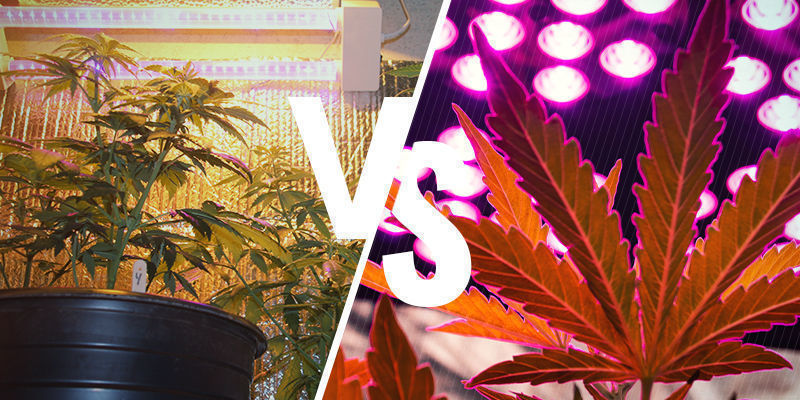
Picking between HPS and LED grow lights is a key decision indoor cannabis growers need to make when setting up their operation. Both types of lighting have unique pros and cons that make them better suited to different types of growers, but with the help of the information listed above, you can make a confident decision to suit your needs and budget.
- (n.d.). LED vs HPS. Mammoth Lighting. https://mammothlighting.com/pages/led-vs-hps Accessed 25.11.2021 - https://mammothlighting.com
- Gianmaria Magagnini, Gianpaolo Grassi, & Stiina Kotiranta. (2018). Magagnini, G et al. The Effect of Light Spectrum on the Morphology and Cannabinoid Content of Cannabis sativa L. Medical Cannabis and Cannabinoids 2018;1:19–27. https://www.karger.com/Article/Fulltext/489030 Accessed 26.11.2021. - https://www.karger.com
-
 6 min
January 17, 2022
Using LED Grow Lights To Maximise Cannabis Yields
Choice; a wonderful freedom or a terrible burden? Choosing how to set up your cannabis grow requires a lot of decisions, not least of all when it comes to lighting. Find out all about LED lights,...
6 min
January 17, 2022
Using LED Grow Lights To Maximise Cannabis Yields
Choice; a wonderful freedom or a terrible burden? Choosing how to set up your cannabis grow requires a lot of decisions, not least of all when it comes to lighting. Find out all about LED lights,...
-
 7 min
November 11, 2021
How The Light Spectrum Affects Cannabis
Cannabis is a sun-loving plant. But growing great weed indoors is about more than just sticking a plant under a strong light and hoping for the best. In this article, we'll teach you all there is...
7 min
November 11, 2021
How The Light Spectrum Affects Cannabis
Cannabis is a sun-loving plant. But growing great weed indoors is about more than just sticking a plant under a strong light and hoping for the best. In this article, we'll teach you all there is...
-
 5 min
October 20, 2020
The Optimal Distance Between Grow Lights And Cannabis Plants
Hanging a grow light in your grow room or tent is just one part of the story. To really get the most out of your cannabis plants, you need to hang your light at the optimal height to support robust...
5 min
October 20, 2020
The Optimal Distance Between Grow Lights And Cannabis Plants
Hanging a grow light in your grow room or tent is just one part of the story. To really get the most out of your cannabis plants, you need to hang your light at the optimal height to support robust...
-
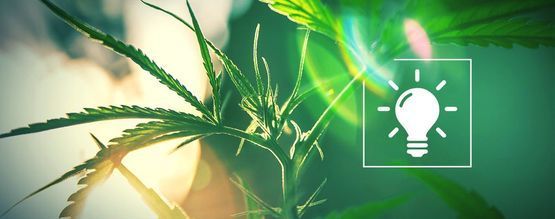 7 min
June 13, 2019
Choosing The Right Light For Your Grow-Op
Cannabis plants have many demands, but none quite as important as lighting. A good set of lights are needed to ensure plants can photosynthesise properly and make enough energy to survive and...
7 min
June 13, 2019
Choosing The Right Light For Your Grow-Op
Cannabis plants have many demands, but none quite as important as lighting. A good set of lights are needed to ensure plants can photosynthesise properly and make enough energy to survive and...











 United States
United States








